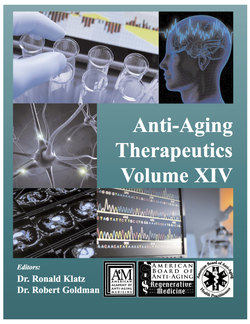Читать книгу Anti-Aging Therapeutics Volume XIV - A4M American Academy - Страница 39
На сайте Литреса книга снята с продажи.
New Options for Testosterone Implantation
ОглавлениеTestosterone therapy has documented benefits in both men and women’s health. However, increased or aberrant aromatase expression (age, obesity, medications, diet, breast cancer, prostate cancer, etc.) and subsequent elevated estradiol can interfere with testosterone’s effectiveness. In addition, there is increasing evidence of the adverse affects of elevated estradiol on prostate, breast, uterus, obesity, metabolic syndrome, and mood.
To prevent these side effects, compounding pharmacists have combined testosterone with anastrozole, an aromatase inhibitor. In an email with Dr. Rebecca Glaser (September 7th, 2011), she wrote: “The biggest difference in my practice now versus when I trained you (2008) is that I am using an aromatase inhibitor much more frequently. We combine testosterone with anastrozole in a pellet implant. It works great. Men increase aromatase activity as they age. Interestingly, 70% of men on pellets do better with the combination. If a male patient isn't doing well on pellets it is almost always estrogen related (aromatization to E2).”
Combining testosterone with anastrozole is:
•Best for men with high-normal or high E2 prior to treatment (usually obese);
•Best for women with active breast cancer;
•Optional for women for whom any estradiol elevation would be undesirable (already elevated levels prior to treatment with HRT, strong FH of breast cancer, obesity with high normal E2 levels prior to treatment.
At the 9th European Congress on Menopause and Andropause (EMAS 2012) in Athens Glaser and Dimitrakakis10 presented a poster of their 2 year record of testosterone/anastrozole (T/A) implantations. They reported that:
•Female indications for using aromatase inhibitor therapy included: a history of breast cancer or increased risk for breast cancer, breast pain, fibrocystic breast conditions, endometriosis, uterine fibroids, dysfunctional uterine bleeding, weight gain, increased abdominal obesity, insulin resistance with elevated estradiol, menstrual or migraine headaches, PMS, anxiety, irritability, aggression, fluid retention, and bloating;
•Male indications included: history of prostate cancer or benign prostatic hyperplasia (BPH) (8%), elevated E2 prior to or on testosterone therapy (86%), and symptoms alone (6%) which include: lack of effect from therapy, fluid retention, bloating, anxiety, irritability, excess aggression, abdominal obesity, weight gain, gynecomastia, and breast pain or enlargement
A chart review of 1,408 T/A pellet insertions performed between July 2009 and July 2011 was also presented (Fig. 1). Insertions were performed on men and women either with testosterone-only or T/A combination pellets.as a sustained-release pellet implant. Results showed that T/A pellets provided therapeutic levels of testosterone without elevating E2 in both men and women, and that E2 levels in the those treated with T/A pellets were significantly lower (P<0.0001) than in those treated with testosterone-only.
Figure 1. Dr. Rebecca Glaser’s 2-year record of testosterone-anastrozole implantations.
According to Yogesh Bhakta PharmD (personal communication) he believed that the ideal combination of testosterone and anastrozole would be 60 mg testosterone and 4 mg anastrozole 4mg pellets. Thus a man needing 1200 mg of T/A pellets would use: 4 x 60 mg/4 mg T/A pellets and 960 mg of testosterone-only pellets. A woman might use 2 of these pellets (120/8). Both T/A and testosterone-only pellets are available from multiple pharmacies.
